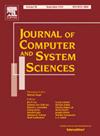Interaction graphs of isomorphic automata networks II: Universal dynamics
IF 0.9
3区 计算机科学
Q1 BUSINESS, FINANCE
引用次数: 0
Abstract
An automata network with n components over a finite alphabet Q of size q is a discrete dynamical system described by the successive iterations of a function . In most applications, the main parameter is the interaction graph of f: the digraph with vertex set that contains an arc from j to i if depends on input j. What can be said on the set of the interaction graphs of the automata networks isomorphic to f? It seems that this simple question has never been studied. In a previous paper, we prove that the complete digraph , with arcs, is universal in that whenever f is not constant nor the identity (and ). In this paper, taking the opposite direction, we prove that there exist universal automata networks f, in that contains all the digraphs on , excepted the empty one. Actually, we prove that the presence of only three specific digraphs in implies the universality of f, and we prove that this forces the alphabet size q to have at least n prime factors (with multiplicity). However, we prove that for any fixed , there exists almost universal functions, that is, functions such that the probability that a random digraph belongs to tends to 1 as . We do not know if this holds in the binary case , providing only partial results.
同构自动机网络的交互图II:通用动力学
在大小为Q的有限字母Q上有n个分量的自动机网络是由函数f:Qn→Qn的连续迭代描述的离散动力系统。在大多数应用中,主要参数是f的交互图:具有顶点集[n]的有向图,如果fi依赖于输入j,则包含从j到i的弧。在与f同构的自动机网络的交互图的集合G(f)上可以说些什么?似乎这个简单的问题从未被研究过。在上一篇文章中,我们证明了具有n2个弧的完全有向图Kn是全称的,即当f不为常数且n≥5时,Kn∈G(f)。本文反其道而行,证明了普遍自动机网络f的存在,即G(f)包含了[n]上除空有向图之外的所有有向图。实际上,我们证明了G(f)中只有三个特定的有向图的存在意味着f的普遍性,并且我们证明了这迫使字母表大小q至少有n个素数因子(具有多重性)。然而,我们证明了对于任意一个固定的q≥3,存在几乎全称函数,即函数f:Qn→Qn使得一个随机有向图属于G(f)的概率在n→∞时趋于1。我们不知道在二进制情况下q=2是否成立,只提供部分结果。
本文章由计算机程序翻译,如有差异,请以英文原文为准。
求助全文
约1分钟内获得全文
求助全文
来源期刊

Journal of Computer and System Sciences
工程技术-计算机:理论方法
CiteScore
3.70
自引率
0.00%
发文量
58
审稿时长
68 days
期刊介绍:
The Journal of Computer and System Sciences publishes original research papers in computer science and related subjects in system science, with attention to the relevant mathematical theory. Applications-oriented papers may also be accepted and they are expected to contain deep analytic evaluation of the proposed solutions.
Research areas include traditional subjects such as:
• Theory of algorithms and computability
• Formal languages
• Automata theory
Contemporary subjects such as:
• Complexity theory
• Algorithmic Complexity
• Parallel & distributed computing
• Computer networks
• Neural networks
• Computational learning theory
• Database theory & practice
• Computer modeling of complex systems
• Security and Privacy.
 求助内容:
求助内容: 应助结果提醒方式:
应助结果提醒方式:


